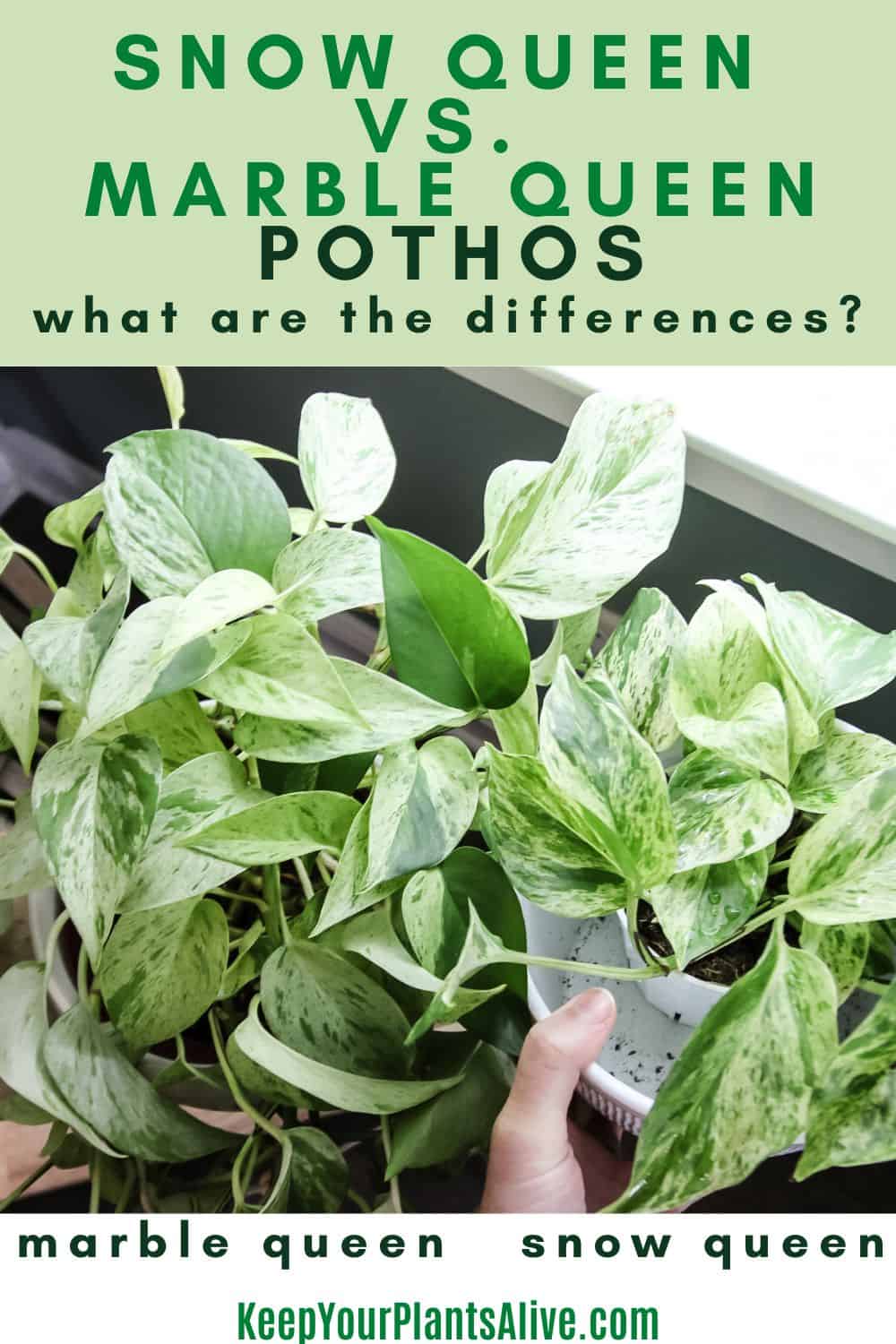Looking for a comprehensive Snow Queen Pothos care guide and pothos plant care tips? Here's everything that you need to ensure your plant thrives!
Pothos plants have surged in popularity, becoming a staple in countless households and offices alike. Their reputation as resilient, low-maintenance plants precedes them, drawing both seasoned plant enthusiasts and beginners into the world of indoor gardening.
There are so many types of pothos available, it is fun to collect them! Each variant boasts its own unique charm, from the classic Golden Pothos to the vibrant Neon Pothos, offering enthusiasts an opportunity to curate a vibrant collection.
Across the spectrum of pothos varieties, the Snow Queen Pothos stands out as a highly sought-after gem among collectors. Its allure lies in the intricate and striking variegation adorning its leaves, featuring lush green hues elegantly interwoven with delicate streaks and patches of pure white.
This distinct variegation pattern sets the Snow Queen apart.
Whether displayed as a trailing vine, perched on a shelf, or cascading elegantly from a hanging planter, the Snow Queen's distinct foliage is really something special.
Let's dive into everything that you need to know before adding a Snow Queen pothos to your collection!
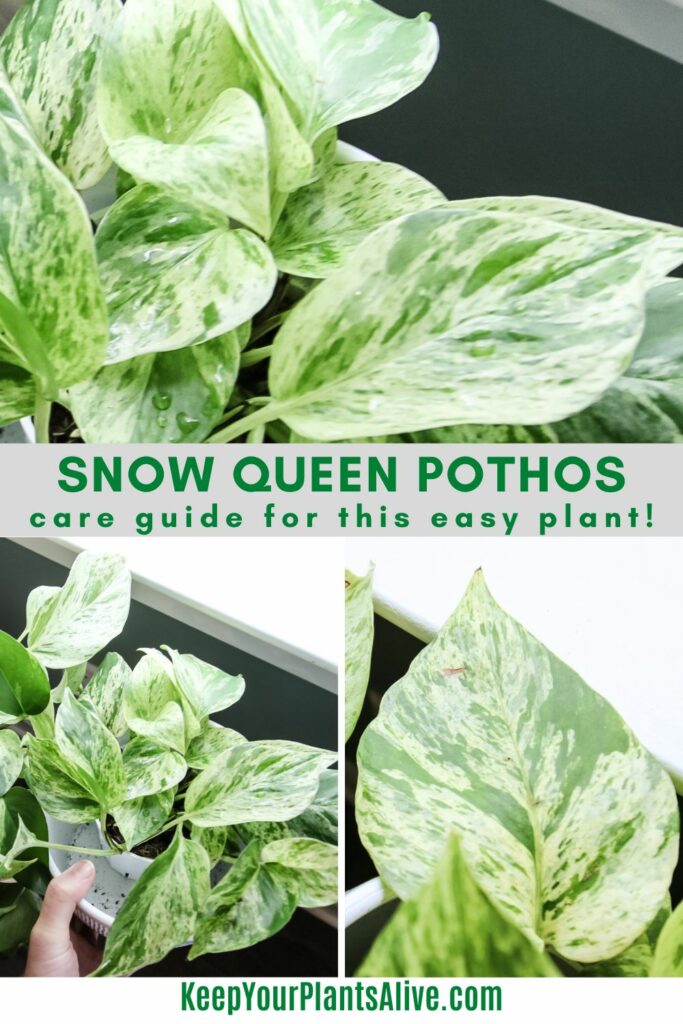
What is Snow Queen Pothos?
Snow Queen Pothos, a variegated Epipremnum aureum, displays lush green leaves accented with delicate streaks and patches of pure white.
Other names for Snow Queen Pothos include:
- Snow Queen Devil’s Ivy
- Variegated Pothos
- Epipremnum aureum 'Snow Queen'
- often confused with Marble Queen pothos
Snow Queen Pothos Origins
The Snow Queen Pothos, scientifically known as Epipremnum aureum 'Snow Queen,' is believed to trace its origins to the lush, tropical landscapes of the Solomon Islands in the South Pacific. These islands, renowned for their rich biodiversity and dense rainforests, serve as the native habitat for this captivating plant species.
Within these vibrant and diverse ecosystems, the Snow Queen Pothos has evolved to thrive amidst the tropical climate, adapting to the warm temperatures and high humidity characteristic of its natural surroundings.
Are Snow Queen and Marble Queen Pothos the Same?
While Snow Queen and Marble Queen Pothos share a species (Epipremnum aureum), their striking variegation patterns and growth habits differentiate them.
Snow Queen Pothos displays a predominantly white variegation with distinct, pronounced streaks of white against lush green leaves.
On the other hand, Marble Queen Pothos has a marbled effect, featuring creamy-white patches intricately blending with vivid green tones.
Overall, Snow Queen is a whiter and more variegated plant compared to the Marble Queen pothos.
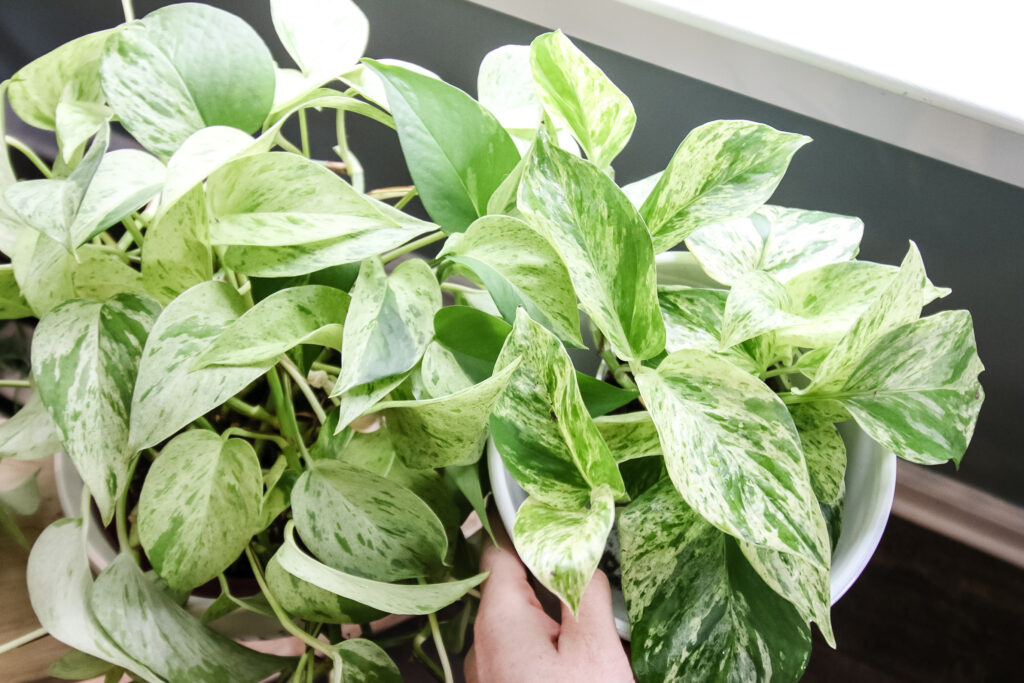
Is Snow Queen Pothos rare?
While not extremely rare, Snow Queen Pothos can be harder to find due to its variegation, occasionally making it more prized among houseplant enthusiasts.
They also can be priced high, accordingly. I suggest shopping for Snow Queen pothos on Etsy!
Is Snow Queen Pothos toxic?
Yes, Snow Queen Pothos is toxic to pets and humans if ingested. Keep it away from curious pets and children.
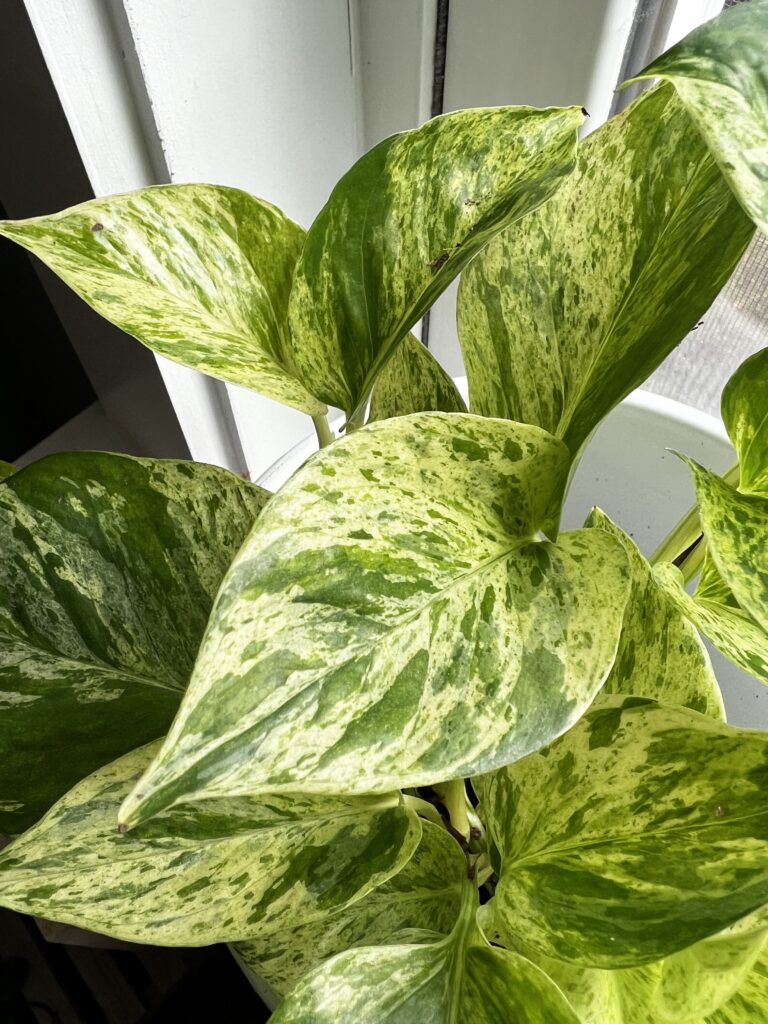
Snow Queen Pothos Care Guide
Here is everything that you need to know about caring for a Snow Queen pothos plant.
Snow Queen Pothos Watering
When watering Snow Queen Pothos, aim to water it once the top inch of the soil feels dry to the touch.
To prevent waterlogging, a crucial step is ensuring that the pot has adequate drainage holes to facilitate the smooth outflow of excess water.
Read my guide on drilling drainage holes in pots!
By allowing the soil to partially dry out between waterings and ensuring proper drainage, you help maintain an optimal moisture balance, preventing the roots from becoming waterlogged or prone to rot.
Should I mist my Snow Queen Pothos?
These plants are native to rainforest areas and like humidity. Occasional misting can benefit Snow Queen Pothos, especially in drier indoor environments.
Snow Queen Pothos Lighting Needs
Snow Queen Pothos flourishes when placed in areas with moderate to bright indirect light, making it ideal for spots with filtered sunlight or slightly shaded locations within a room.
Direct sunlight should be avoided as it can be too intense for the plant, potentially causing leaf burn or scorching.
By providing the right balance of indirect light, you ensure the Snow Queen Pothos receives adequate energy for healthy growth without risking damage to its foliage.
Can I keep Snow Queen Pothos outdoors?
While it can tolerate outdoor conditions in warmer climates, it generally prefers indoor settings with stable temperatures.
Move your plant indoors if temperatures fall under 50 degrees at night and always keep out of direct sunlight.
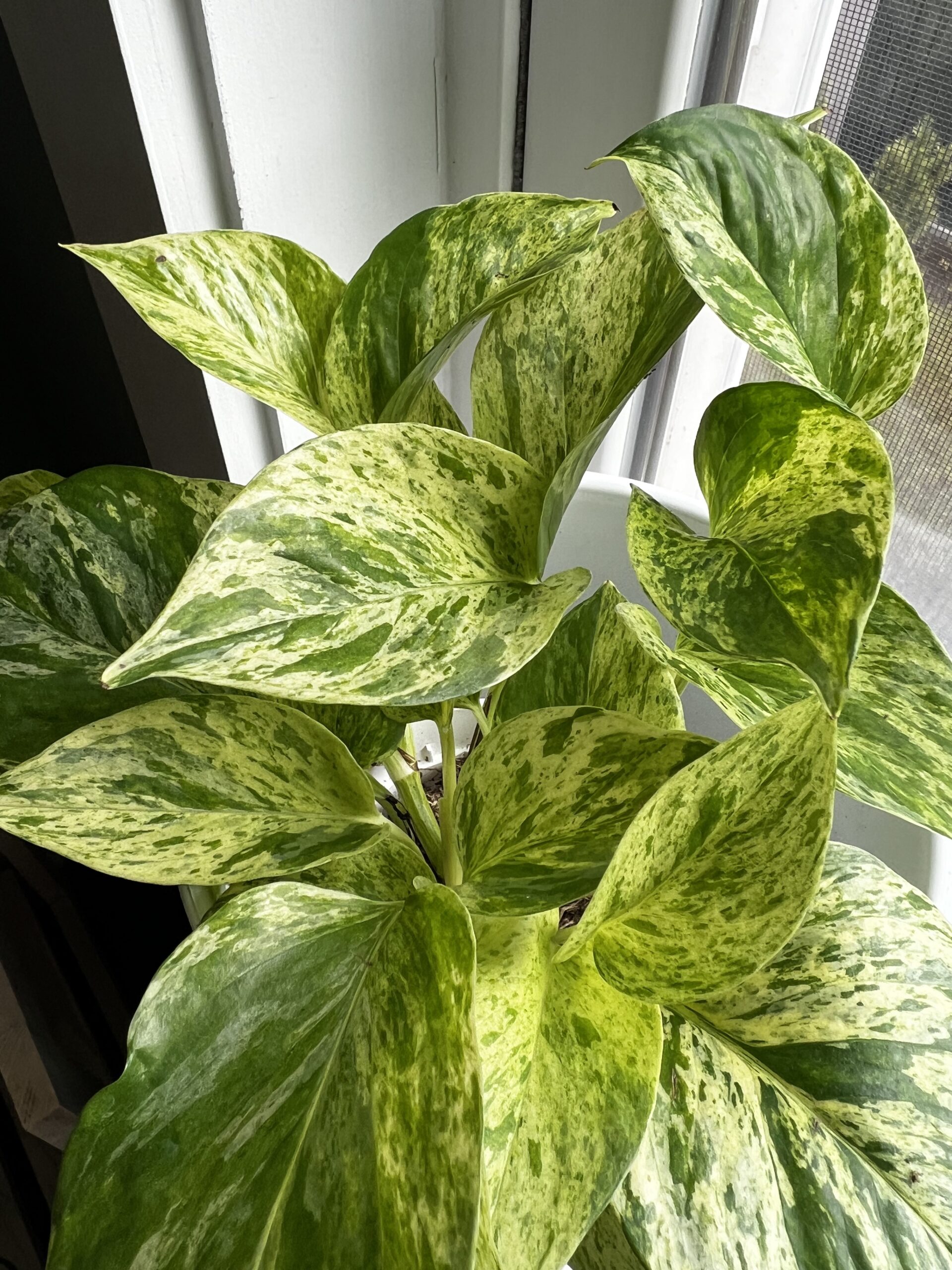
Snow Queen Pothos Soil + Potting
Snow Queen Pothos thrives in well-draining potting mixtures that retain some moisture without becoming waterlogged. A blend of peat, perlite, and pine bark or coco coir offers excellent aeration and moisture retention, fostering a conducive environment for root health.
When potting the Snow Queen Pothos, ensure the container has drainage holes to prevent water accumulation at the bottom, allowing excess moisture to escape.
The plant prefers slightly acidic to neutral soil pH levels, typically ranging between 6.1 and 7.0, ensuring optimal nutrient uptake for robust growth.
Regularly refreshing the soil every couple of years or as the plant grows helps maintain its vitality and supports healthy foliage development.
Does Snow Queen Pothos like to be root-bound?
Snow Queen Pothos can tolerate being slightly root-bound but benefits from repotting when it outgrows its container.
Does Snow Queen Pothos need a moss pole?
A moss pole isn't necessary, but it can encourage upright growth and larger leaves. I only add a moss pole if the branches start getting super long and I don't have the space for them to hang.
Here's my guide on how to make a moss pole!

Snow Queen Pothos Fertilization
Feeding Snow Queen Pothos with a balanced liquid fertilizer is crucial for its optimal growth. Dilute the fertilizer to half strength to prevent overwhelming the plant with nutrients.
Administering this solution every 4 to 6 weeks during the active growing season, typically in spring and summer, supplies essential nutrients that promote vibrant foliage and healthy root development.
Ensure that the fertilizer application occurs when the soil is already moist to prevent any potential stress on the roots.
Additionally, refrain from fertilizing during the dormant season in fall and winter, as the plant's growth slows down, reducing its need for additional nutrients.
This feeding routine supports Snow Queen Pothos in maintaining its vigor and lush appearance throughout the growing period.
How to Propagate Snow Queen Pothos
It is extremely easy to propagate Snow Queen Pothos in water!
- Identify a healthy branch, preferably with new growth.
- Snip the branch with sharp scissors.
- Remove any lower leaves.
- Place in water so at least 1 - preferably 2 - nodes are underwater.
- Change the water once a week and top off as necessary.
- See roots form in 2-4 weeks.
- Once the roots are 2-3 inches long, plant in soil.

Troubleshooting Snow Queen Pothos
These plants are generally easy to care for, but they can give you some trouble. Here are common problems and how to fix them!
Why are the leaves of my Snow Queen Pothos turning yellow?
Yellowing leaves could be due to overwatering, inadequate light, or poor drainage. Ensure the plant is not sitting in water, adjust watering frequency, and provide sufficient indirect light.
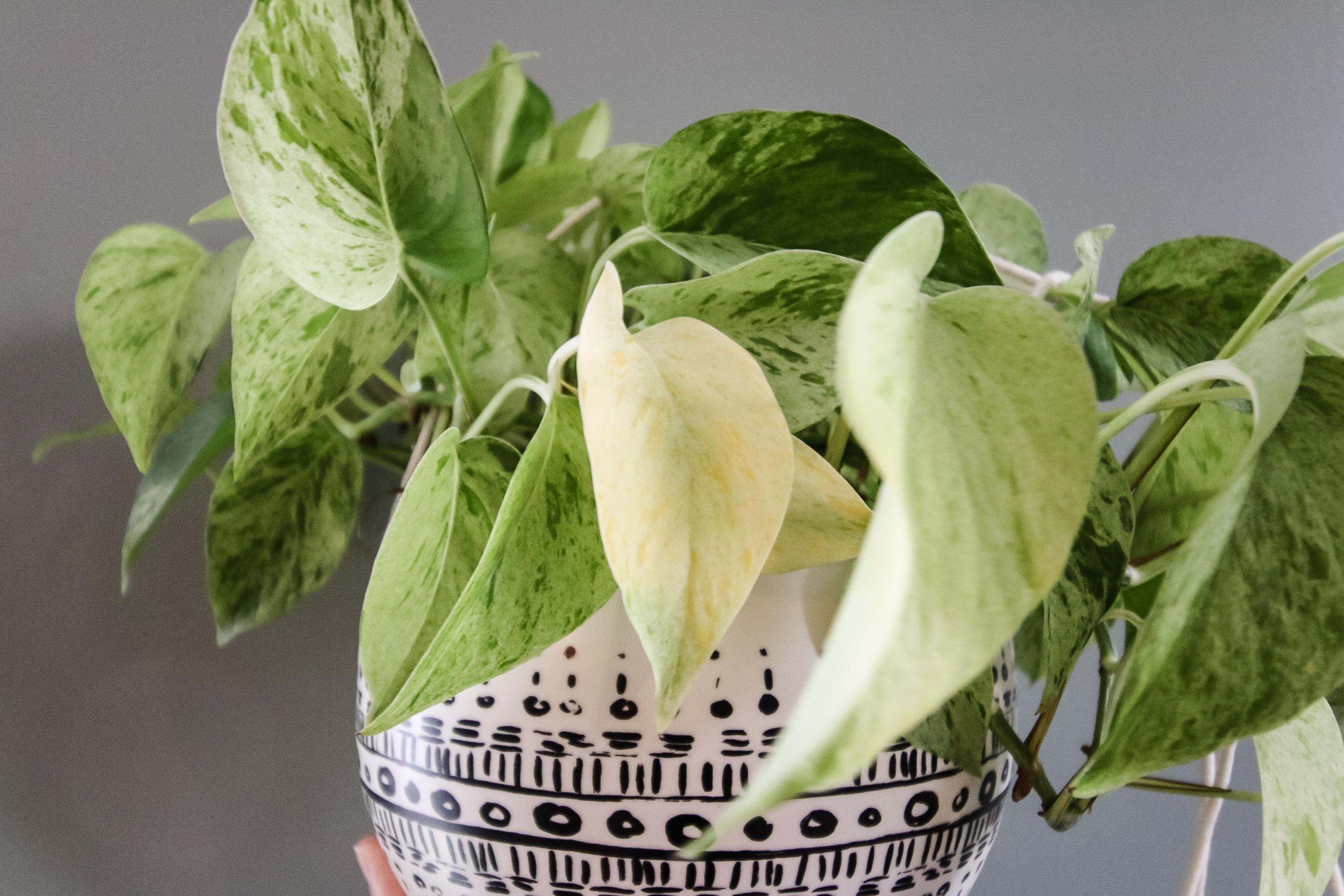
How do I prevent my Snow Queen Pothos from getting leggy?
To prevent legginess, regularly prune the plant by cutting back overgrown stems. Stick those cuttings in water and they will root!
Ensure it receives adequate light to promote bushier growth.
What should I do if I notice brown tips on my Snow Queen Pothos leaves?
Brown tips are often a sign of dry air or inconsistent watering. Increase humidity by misting the leaves and ensure proper watering practices, allowing the soil to slightly dry between waterings.
You can remove or trim any brown leaves!
Why is my Snow Queen Pothos not growing new leaves?
Insufficient light or lack of nutrients could be causing slow growth. Move the plant to a brighter location and consider feeding it with a balanced fertilizer during the growing season.
How can I prevent root rot in my Snow Queen Pothos?
To prevent root rot, ensure proper drainage by using well-draining soil and a pot with drainage holes. Avoid overwatering and remove excess water from saucers or trays to prevent waterlogging.
Other pothos content you might enjoy:
- Golden pothos care guide
- Cebu Blue pothos care guide
- Baltic Blue pothos care guide
- Marble Queen pothos care guide
- Global Green pothos care guide
- Neon pothos care guide
- NJoy Pothos Care Guide
- Why are my pothos leaves turning yellow?
- Why are my pothos leaves turning brown?
- Why is my pothos plant not growing leaves?
- Why are my pothos cuttings rotting
- How to move pothos from water to soil
- Should I mist my pothos?
- How to make pothos fuller
- Can you propagate pothos without a leaf?
- Can you propagate pothos from a leaf?
- Can you propagate a long pothos vine?
- Where to cut pothos for propagation
- Pothos vs Snake plants: which is better for beginners?
- Cebu Blue Pothos vs Baltic Blue Pothos
- How to propagate pothos
- How to propagate golden pothos
- How to propagate a satin pothos
- How to propagate pothos in soil
- How often to water pothos plants
- How to care for variegated pothos
- How to revive a dying pothos plant
- Why are my Pothos leaves curling?
- How to identify and treat common pothos pests
- How to divide pothos plant
- How to make pothos grow bigger leaves
- Why does my pothos only have one vine?
- Can you grow pothos in low light conditions?
- How to cut off dead pothos leaves
- Are pothos plants toxic to cats and dogs?
- Can you grow pothos in water?
- Why is my pothos droopy?
- Why is my pothos plant dropping leaves?
Printable Pothos Plant Care Guide
Join the (free!) KeepYourPlantsAlive+ community to access this exclusive printable plant care guide! Or keep scrolling for more!

Thanks for reading!


Hey there, I'm Morgan, a houseplant enthusiast from sunny Charleston, South Carolina. Growing up surrounded by my mom's lush orchids and African violets, I discovered the magic of bringing nature indoors. Thanks to the pandemic, I delved deeper into houseplants, discovering their power to uplift moods and transform spaces. I'm here to spill all my secrets, helping you pick the perfect houseplant - and make it happy. Let's keep your plants alive, together! 😊

